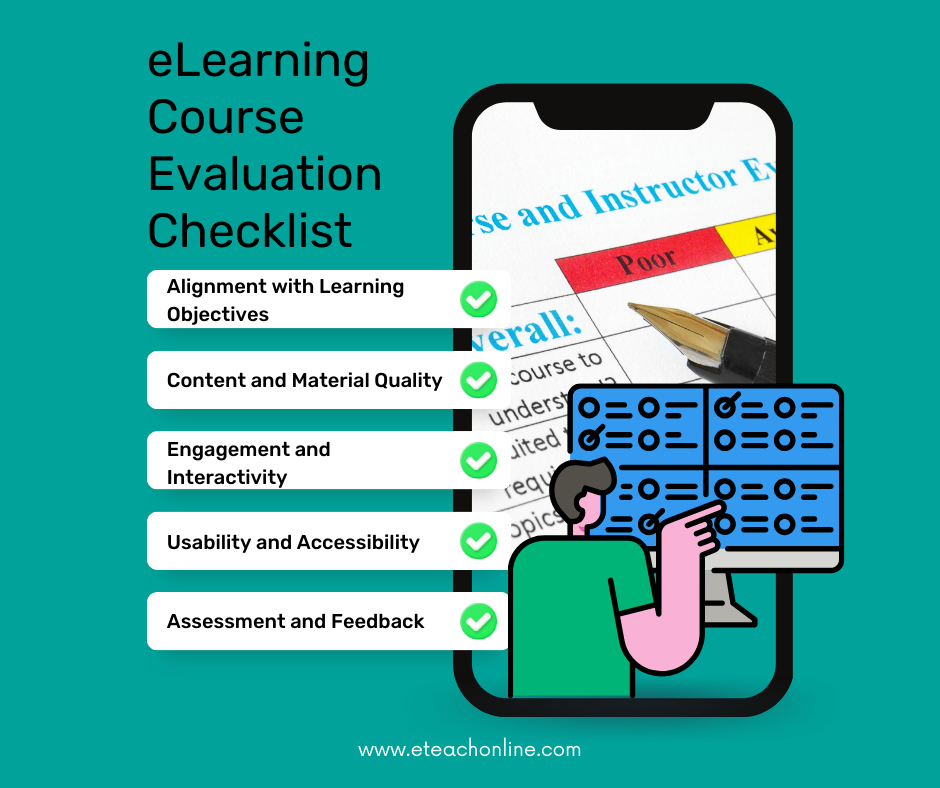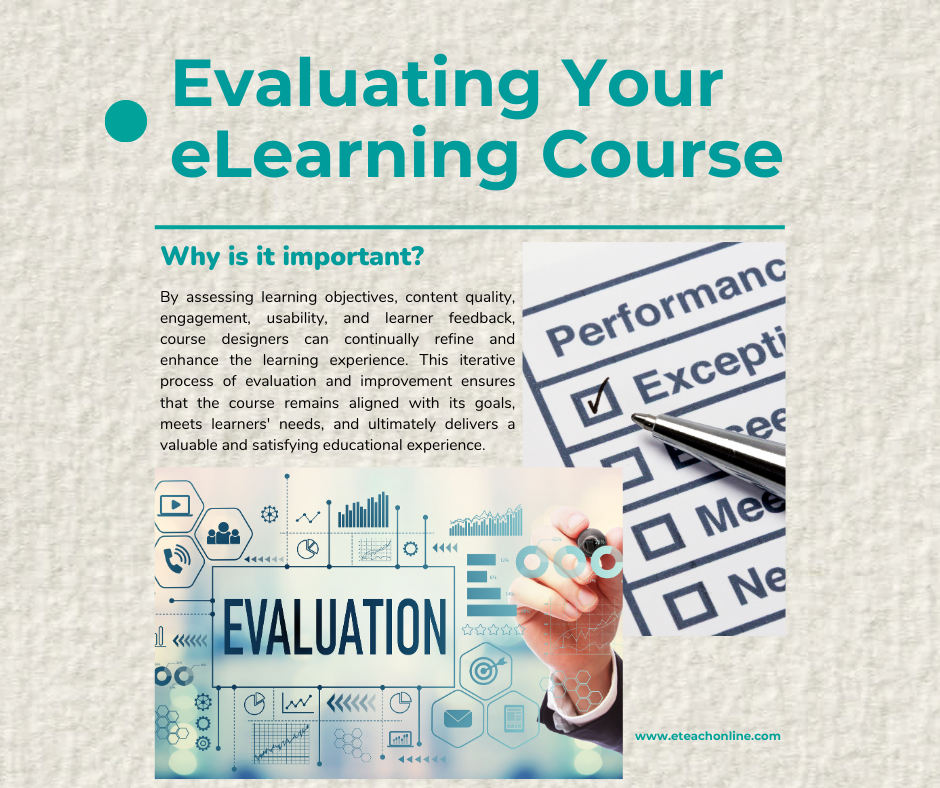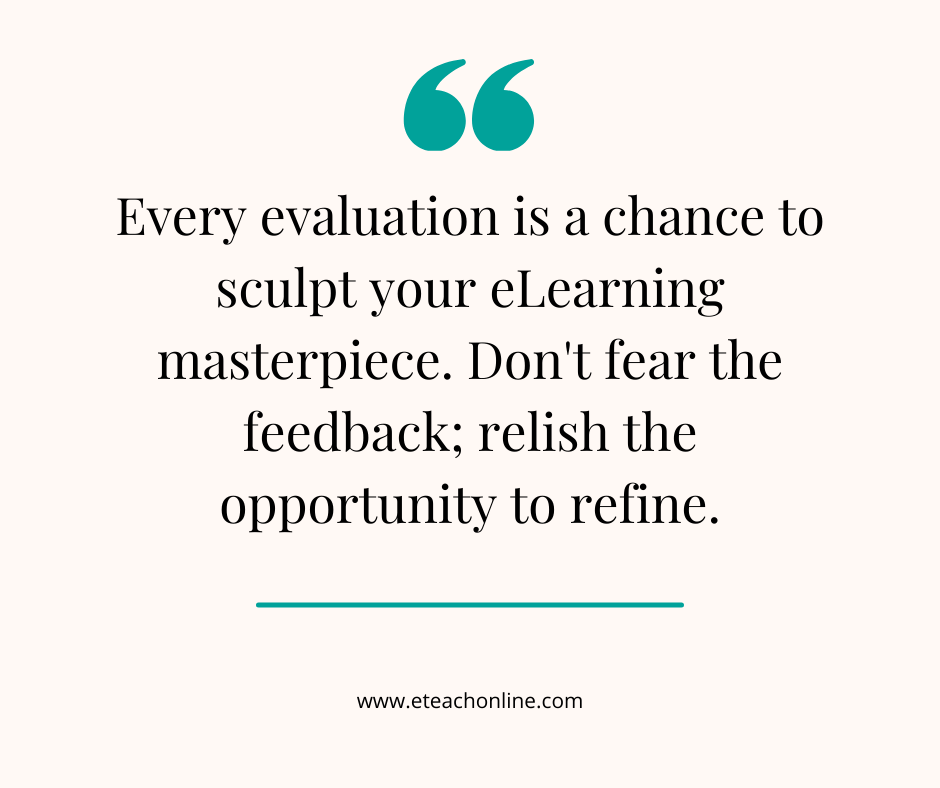Unlock the Episode: Listen and Download the Free MP3 from My Podcast Today!
SUMMARY
Designing eLearning content is a substantial undertaking, and evaluating its effectiveness is crucial. eLearning course evaluations play a pivotal role in assessing the quality of your content and continuously enhancing the learning experience. These evaluations occur before, during, and after instruction.
When planning your materials, it's essential to evaluate the suitability of technology resources and reading materials for your eLearning course. At the end of each lesson or module, comprehensive evaluation is necessary, encompassing learning objectives, media, activities, and assessment strategies.
Why are eLearning course evaluations important? They help determine if your course meets its goals and learning objectives, ensuring its effectiveness. Evaluation also identifies areas that need improvement, making continuous enhancement a top priority. When should you use course evaluations? Throughout the course's development and delivery, feedback from learners is essential. Whether in the development phase or after completion, feedback helps instructors and designers make necessary adjustments for better results.
Evaluations should be ongoing, with regular assessments to keep improving the course. Utilizing a learning management system can assist in tracking learner performance and progress, aiding in identifying issues or areas that need modification.
To evaluate instructor performance and materials, administer surveys throughout the course, seeking learners' opinions on resources and instructor effectiveness. Ensure survey responses are anonymous, allowing honest feedback.
Reflection is crucial, encouraging learners to assess their experiences, content perception, and the learning process. Designers can use this feedback to make necessary revisions.
Ask key questions like: Did learners achieve the intended learning outcomes? Was the chosen technology effective? What should be revised or retained? How can engagement be improved? How can real-world connections be made?
To achieve high response rates, have learners complete evaluations after each module, make evaluations available as modules open, and emphasize the importance of their feedback. Consider incentives and share how past feedback has been incorporated into courses.
Effective feedback strategies include clear survey purposes, specific and focused questions, avoiding leading questions, and providing space for both closed and open-ended responses. Avoid demographic questions to ensure anonymity. Continuously evaluate course materials every few months to maintain course effectiveness and improve the learning experience. Though evaluating instructional materials may seem time-consuming, it ultimately enhances your eLearning course's quality.
In conclusion, eLearning course evaluations are a vital part of creating effective online courses and ensuring learner satisfaction. Embrace ongoing evaluation to continuously improve your eLearning materials and offer an exceptional learning experience.
INSPIRATIONAL QUOTES







TRANSCRIPT
Hello, and welcome to the elearning and instructional design for beginners podcast, where new and aspiring instructional designers start, grow and advance their careers and instructional design, and online learning development. I'm your host, Crystal Harper. I'm a former school teacher who transitioned to instructional design, all while working full time as a single mom, would you like to become a successful instructional designer without the burden of earning another degree? Well, then let's get started.
As you've come to learn, designing elearning content is a great deal of work. So it's super important that you determine the effectiveness of all your hard work. elearning course evaluations provide you with the effectiveness of your deliverables. They also help you continuously improve the course in order to offer your learners with the most influential and memorable elearning experience. evaluation takes place prior to instruction, during instruction and after instruction has taken place.
As you plan your materials, you need to evaluate the appropriateness of the technology resources, reading materials, etc, that are intended to be used in the eLearning course. At the end of each lesson or module, it's important to evaluate all aspects of the learning experience. This includes evaluating the learning objectives, the media and materials used, the activities your students engaged in, and the assessment strategies utilized, they need to engage in a reflective evaluation.
Now, why are elearning course evaluations important? The most essential reason that evaluating your content is so important is because it's necessary for you to know if your course is effective. Most specifically, you need to determine if it achieves the course goals and learning objectives. In order to determine whether these things have been accomplished evaluation is necessary. Evaluation provides you with the ability to assess the course quality and effectiveness. In addition, evaluations help you understand what did and didn't work, continuous improvement of your elearning course content needs to be one of your top priorities.
So when should you use course evaluations? You need feedback from the learners in the course. But when before you release your elearning course or after it's completed? The answer is actually throughout its entirety. Whether you are still in the development process, or the learners have just completed the course, the instructor and designer need to receive feedback so that you can keep moving forward and know what adjustments need to be made. This will help give you better results next time.
Evaluations need to be an ongoing process. You must constantly evaluate elearning courses in order to keep improving them and making regular changes and updates. The learners will appreciate your efforts by experiencing the course you are offering them to the fullest.
So now let's discuss how you should go about conducting your learner course evaluations, conducting surveys and questionnaires is the content easy to understand? Are the scenarios you're using relevant to the learners? Are the activities motivating? Is the language appropriate? Are the images and graphics appealing? Are the instructions clear? Are the interactive activities engaging? Once you ensure that your course goals and learning objectives are clear and specific, you need to collect feedback from the learners create questions that align with the course goals and objectives. Ask the learner these types of questions. Ask them anything you have in mind, record the responses, analyze the data, then revise and modify your elearning course accordingly. conducting surveys and questionnaires help give designers the chance to prevent errors and resolve issues and future courses.
You can keep track of things like online learner performance, learners progress completion rates. The feedback that you received through a learning management system is actually one of the easiest and often overlooked forms of evaluating an elearning course. Many learning management systems feature reports that provide you with detailed tracking of every aspect of the elearning course.
Some of the aspects include, if you notice that many of the learners are unable to finish an activity this may indicate that the difficulty level is too high. In contrast, if the learners are breezing through the lesson and record time, it may mean that you need to make the lesson a little bit more challenging.
To evaluate instructor performance and materials. Surveys should be administered to the learners throughout the course asking their opinions of the resources used in the course as well as instructor effectiveness. This is an opportunity for the learners to give candid feedback other instructor And the course materials and what could be improved, survey responses should be completely anonymous. Another option would be to give the learners an opportunity to reflect on parts of the course that they liked or didn't like.
Reflection is thinking back on all the components of the instructor and learning process and determining the effectiveness of each component. In addition, learners can be asked to reflect on their learning experiences, their perceptions on the content learned, and their evaluation of the learning process. Designers can then take this into consideration as they consider any necessary revisions.
You need to ask yourself, did the learners learn what you wanted them to learn? Can the learners demonstrate understanding of the content? was the chosen technology effective and achieving the learning objectives? shared learning objectives be taught in a different format? Would these learning objectives be better taught with another technology? Can the learners work cooperatively with a partner on this lesson? Would parts of the content be better understood if the learners worked in individually? What would you change? What would you keep the same? How will you revise the lesson? How can you make the course or an assignment more engaging? How can you enhance the instructor learner or social presence factors and a lesson or the course? How can you enrich the content to offer more than text? How can you provide more options and encourage active learning? How can you draw real world connections to the lesson and and help your learners do the same when moving from face to face online? What existing activities will work in the context of an online environment in which needs to be transformed or replaced?
Now we'll discuss how you achieve high response rates from your learners. You need to have your learners complete one evaluation after they complete each module or lesson. Give them ample time to complete the evaluation. Make it available to them as each new module is open. Encourage them to complete the evaluation by discussing its purpose and importance ahead of time. If the learners know that their feedback will be read and that changes may be seriously considered based on their feedback, they will be more likely to complete the evaluation.
Share how you have incorporated past feedback into your courses provide a small incentive for completing the evaluations. One way of doing this is by making the evaluation and assignment with points attached or giving learners bonus incentives. Ask the learners to provide feedback about their own learning relative to the courses learning outcomes.
Here are some strategies to obtain more effective feedback clearly state the purpose and importance of the course evaluation at the top of the survey. meaningful input from the learners is essential for improving your learning materials. Obtaining learner feedback on their learning is important to you create questions that are clear and focused and purpose guide learners to the specific type of feedback that you're looking for.
Learners like anyone answering questions tend to provide better feedback to more specific questions. Asking about a specific type of activity or asking students to share the most important point they learned during the instruction may provide more useful feedback. For example, instead of asking how useful were the instructional materials and activities for this course, focus on a specific material or activity. Avoid leading questions. Yes or no questions can often be leading questions.
Instead of asking, Did you learn a great amount from this course a better question would be to what extent do you feel you master the content in this course, provides space for both closed and open ended questions. Asking open ended questions can help you gain insight you may not otherwise receive. Consider not asking demographic questions. Learners are hesitant to complete course evaluations if they feel they might be identified by their responses.
You should continuously evaluate course materials every three to six months once the course is up and running. This is an essential step in creating effective elearning courses. Evaluations help you continuously improve online courses, offering the learners with the most influential and memorable elearning experience. reviewing all the provided feedback determining how well your learners mastered the content and assessing the technology tools and resources will help you determine how you can continuously in Improve your online course.
Now evaluating instructional materials may seem tricky and time consuming, but it's well worth it in the long run. Applying the suggestions provided in this workshop will definitely make your online course stand out above the rest.
Now remember, following these suggestions will not only enhance the effectiveness of an elearning course, but increase the learner satisfaction in order to determine whether these things have been accomplished evaluation is necessary. Evaluation provides you with the ability to assess the course quality and effectiveness. In addition, evaluations help you understand what didn't didn't work, continuous improvement of your elearning course content needs to be one of your top priorities. evaluation needs to be an ongoing process, you must constantly evaluate your learning courses in order to keep improving them and making regular changes and updates.
The learners will appreciate your efforts by experiencing the course you're offering them to the fullest.
Now if you have any questions at all about evaluating instructional materials, be sure to post it in the comments. I'll get to your answers as soon as I finish telling you about how you can get all the help you need to being successful in instructional design. I'd also like to know from you if you have any other suggestions to add about evaluating instructional materials? What are some of your evaluation tips that you wish you knew a long time ago?
JOIN THE
eLearning and Instructional Design for Beginners Community
- In-depth courses & training
Access my rapidly growing library, attend monthly live training & accountability support groups
- Exclusive tools & members-only discounts
Tools, templates, downloads, checklists and more - plus receive special perks & discounts
- Supportive community & network
Feedback and support from fellow instructional designers, career-driven business owners, and experts who will keep you on track
Get Your Software Toolkit for Instructional Designers
Tools & processes that will help you plan, build, and grow your instructional design career and freelance business.



